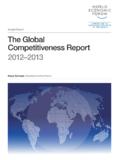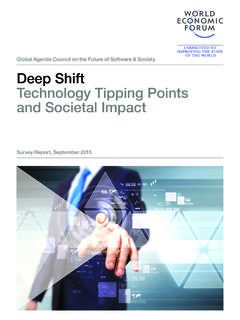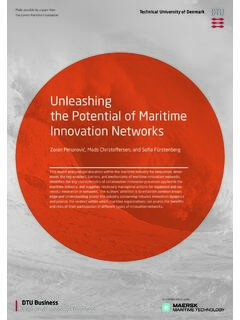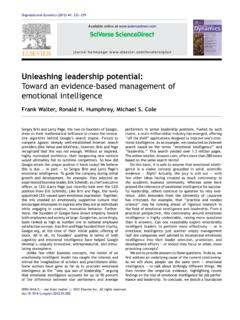Transcription of Industry Agenda Industrial Internet of Things: Unleashing ...
1 Industry Agenda Industrial Internet of Things: Unleashing the potential of Connected Products and Services In collaboration with Accenture January 2015. Contents Executive summary 3. General findings 7. The state of the market 7. The four phases of the Industrial Internet evolution 8. Key near-term opportunities and benefits 9. Major challenges and risks 10. Convergence on the outcome economy 12. From connected products to software-driven services 12. The emergence of the outcome economy 13. Delivering outcomes through connected ecosystems and platforms 14. Shift towards an integrated digital and human workforce 17. Enhancing productivity and work experience through augmentation 17. Creating new jobs in hybrid industries 18. Reskilling for digital industries 18. Recommended actions for stakeholders 21. Appendix A: About the research 29.
2 Appendix B: Glossary 32. References 33. Acknowledgments 34. world economic forum . 2015 All rights reserved. No part of this publication may be reproduced or Transmitted in any form or by any means, including Photocopying and recording, or by any information storage and retrieval system. REF 020315. 2 Industrial Internet of Things Executive summary During the past 15 years, the Internet revolution has redefined business- to-consumer (B2C) industries such as media, retail and financial services. In the next 10 years, the Internet of Things revolution will dramatically alter manufacturing, energy, agriculture, transportation and other Industrial sectors of the economy which, together, account for nearly two-thirds of the global gross domestic product (GDP). It will also fundamentally transform how people will work through new interactions between humans and machines.
3 Dubbed the Industrial Internet (of Things), this latest wave of technological change will bring unprecedented opportunities, along with new risks, to business and society. It will combine the global reach of the Internet with a new ability to directly control the physical world , including the machines, factories and infrastructure that define the modern landscape. However, like the Internet was in the late 1990s, the Industrial Internet is currently in its early stages. Many important questions remain, including how it will impact existing industries, value chains, business models and workforces, and what actions business and government leaders need to take now to ensure long-term success. To address these and other questions facing business and government leaders, the world economic forum 's IT Governors launched the Industrial Internet initiative at the Annual Meeting 2014 in Davos, Switzerland.
4 During the last eight months, the project team has developed a guiding framework and conducted a series of research activities, including in-person workshops, virtual working group sessions, interviews of key thought leaders, and a survey of innovators and early adopters around the world (information about this research can be found in Appendix A). Key research findings Our research concludes that the Industrial Internet is indeed transformative. It will change the basis of competition, redraw Industry boundaries and create a new wave of disruptive companies, just as the current Internet has given rise to Amazon, Google and Netflix. However, the vast majority of organizations are still struggling to understand the implications of the Industrial Internet on their businesses and industries. For these organizations, the risks of moving too slowly are real.
5 Opportunities and benefits Our research reveals that disruption will come from new value creation made possible by massive volumes of data from connected products, and the increased ability to make automated decisions and take actions in real time. The key business opportunities will be found in four major areas: Vastly improved operational efficiency ( , improved uptime, asset utilization) through predictive maintenance and remote management The emergence of an outcome economy, fuelled by software-driven services; innovations in hardware; and the increased visibility into products, processes, customers and partners New connected ecosystems, coalescing around software platforms that blur traditional Industry boundaries Collaboration between humans and machines, which will result in unprecedented levels of productivity and more engaging work experiences Industrial Internet of Things 3.
6 As the Industrial Internet gains broader adoption, businesses will shift from products to outcome-based services, where businesses compete on their ability to deliver measurable results to customers. Such outcomes may range from guaranteed machine uptimes on factory floors, to actual amounts of energy savings in commercial buildings, to guaranteed crop yields from a specific parcel of farmland. Delivering such outcomes will require new levels of collaboration across an ecosystem of business partners, bringing together players that combine their products and services to meet customer needs. Software platforms will emerge that will better facilitate data capture, aggregation and exchange across the ecosystem. They will help create, distribute and monetize new products and services at unprecedented speed and scale. The big winners will be platform owners and partners who can harness the network effect inherent in these new digital business models to create new kinds of value.
7 For instance, Qualcomm Life's 2net platform supports a wide range of connected devices that can all contribute patient health data to improve hospital-to-home health and economic outcomes. Our research also shows that the Industrial Internet will drive growth in productivity by presenting new opportunities for people to upgrade skills and take on new types of jobs that will be created. An overwhelming majority of executives we surveyed believe that the growing use of digital labour in the form of smart sensors, intelligent assistants and robots will transform the skills mix and focus of tomorrow's workforce. While lower-skilled jobs, whether physical or cognitive, will be increasingly replaced by machines over time, the Industrial Internet will also create new, high- skilled jobs that did not exist before, such as medical robot designers and grid optimization engineers.
8 Companies will also use Industrial Internet technologies to augment workers, making their jobs safer and more productive, flexible and engaging. As these trends take hold, and new skills are required, people will increasingly rely upon smart machines for job training and skills development. Risks and challenges To realize the full potential of the Industrial Internet , businesses and governments will need to overcome a number of important hurdles. Chief among them are security and data privacy, which are already rising in importance given increased vulnerabilities to attacks, espionage and data breaches driven by increased connectivity and data sharing. Until recently, cybersecurity has focused on a limited number of end points. With the advent of the Industrial Internet , these measures will no longer be adequate as the physical and virtual worlds combine at a large scale.
9 Organizations will need new security frameworks that span the entire cyber physical stack, from device-level authentication and application security, to system-wide assurance, resiliency and incidence response models. Another crucial barrier is the lack of interoperability among existing systems, which will significantly increase complexity and cost in Industrial Internet deployments. Today's operational technology systems work largely in silos. However, in the future, a fully functional digital ecosystem will require seamless data sharing between machines and other physical systems from different manufacturers. The drive towards seamless interoperability will be further complicated by the long life span of typical Industrial equipment, which would require costly retrofitting or replacement to work with the latest technologies.
10 In addition, other notable barriers and risks include uncertain return on investments on new technologies, immature or untested technologies, lack of data governance rules across geographic boundaries and a shortage of digital talent. Overcoming these challenges will require leadership, investment and collaborative actions among key stakeholders. 4 Industrial Internet of Things Summary of recommendations To seize near-term opportunities, capitalize on the long-term structural shift and accelerate the overall development of the Industrial Internet , our research recommends the following actions: Technology providers should begin to inventory and share best security practices, perhaps by establishing a global security commons. They should participate in the development of technology test-beds to demonstrate how solutions from different organizations can work together.



















